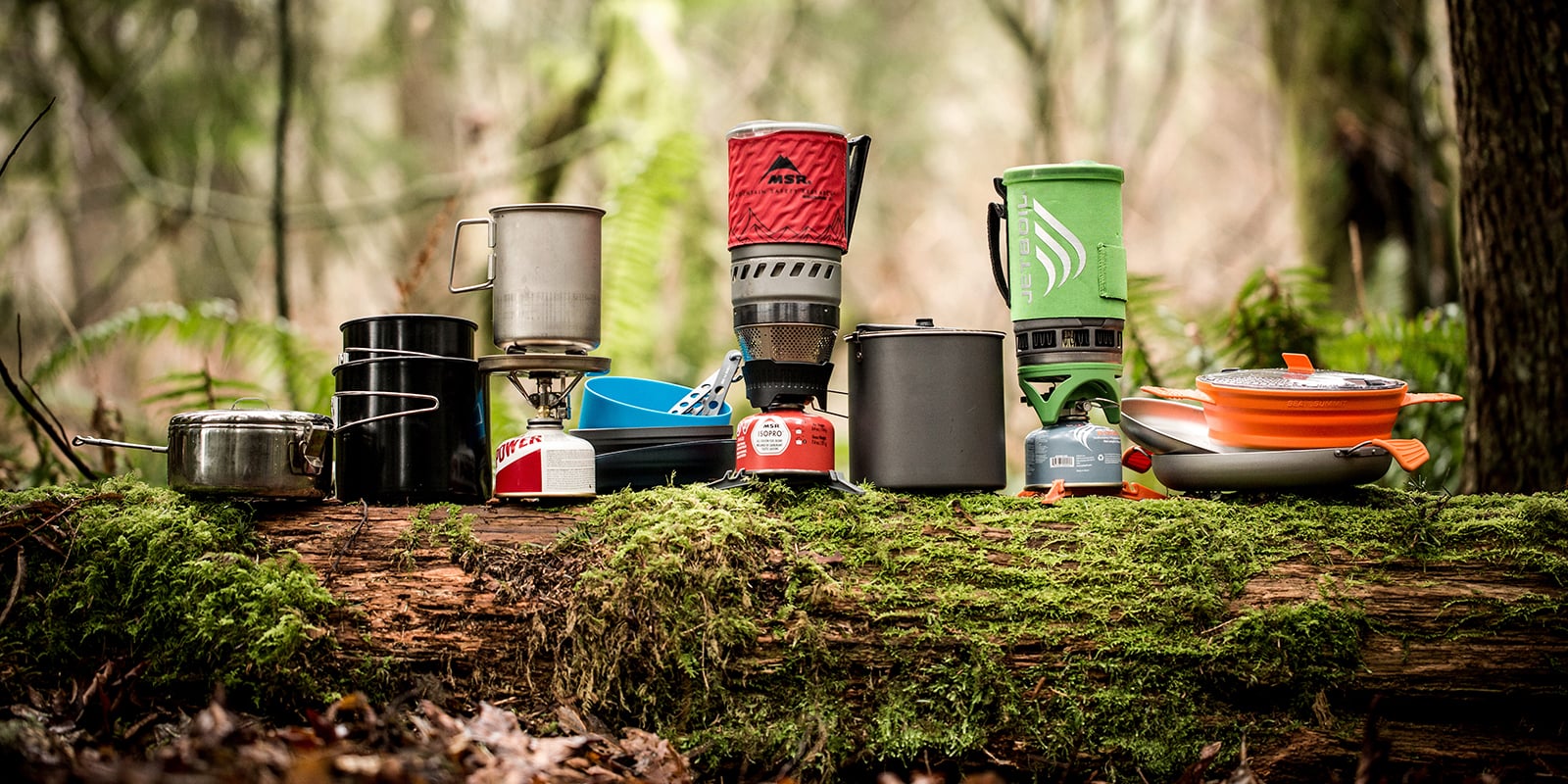How to Choose a Backpacking Stove

Featuring an award-winning micro regulator for strong performance in cold and windy weather, the Soto WindMaster stove comes with a 4Flex pot support for stable performance.




$6
10% Reward
on this and every eligible full-price item*
+
$30
Bonus Card
valid for 30 days after joining*
=
$36
Value
Keep shopping
Imported.
View all Soto Backpacking Stoves| Best Use | Backpacking |
|---|---|
| Fuel Type | Canister |
| Fuel | Isobutane-propane |
| Number of Burners | 1 Burner |
| Burn Time (Max Flame) | 90 min. (per 250g canister) |
| Average Boil Time (1L) | 4 min. 2 sec. |
| Ultralight | Yes |
| Dimensions | 5.7 x 3.8 x 1.3 inches |
| Weight | 3.1 ounces |
Adding a review will require a valid email for verification
So far, I really like this stove. The design is simple and elegant and it operates similarly to my MSR PocketRocket Deluxe stove. The weight of the Soto WindMaster with the 4Flex (4 arm) pot support installed weighs 86 grams (~3 oz) on my scale, which is 3 grams heavier than the MSR stove that weighs in at 83 grams (~2.9 oz). Although the Soto WindMaster comes standard with the 4Flex pot holder, the optional TriFlex (3 arm) pot support, which is available directly from Soto or from other online stores, reduces the weight of the stove from 86 grams to 66 grams; 17 grams (0.6 oz) less than the PocketRocket Deluxe. In terms of overall design, both stoves visually appear to burn similarly with respect to their flame profile. The advertised boil time for 2-1/2 cups of water is 2.5 minutes and 3.3 minutes, respectively, for the WindMaster and PocketRocket Deluxe. I haven't personally put a stop watch to the stoves. The most visually obvious difference between the two stoves is with their height. The Soto stove is 88 mm tall (~3.5 in.) while the PocketRocket Deluxe's height is 83 mm (~3.25 in.). Unlike the MSR PocketRocket Deluxe, the taller height of the Soto stove prevents it from being stored in my 750 ml Toaks pot along with a 110 gram fuel canister, thereby necessitating that either the stove or canister be stored separately from the pot. To me, that's a trivial issue as I will willingly trade fuel efficiency and lighter weight over storage convenience. Another advantage I see with the Soto WindMaster stove design over that of the PocketRocket Deluxe is in how it's designed for maintainability, specifically in regard to the piezoelectric igniter. For the average individual, should the igniter fail, as most igniters eventually do, the MSR stove must be returned to the manufacturer for repair. This is not the case with the Soto WindMaster. Soto sells the igniter as a standalone replacement part that can be easily installed with a simple phillips head screwdriver. Soto has gone as far as to produce YouTube videos outlining the steps to execute this and other repairs. So, in summary, I would recommend the Soto WindMaster to anyone looking for a well designed stove that will help them lighten their load and potentially extend their fuel.
The Soto Windmaster takes a place as being a top favorite among my canister stoves and I don’t say this lightly as I have more than 15 canister stoves as a collector. It looks to be built off of the base or "platform" as the Soto Micro Regulator: There’s a full base with an outer o-ring that seats against the canister but the difference is in the head of the Windmaster. At first I thought the big improvement on the Windmaster was the wind resistance, which it definitely has but I was more surprised by how the flame forms a flat, pan or pot hugging "disk” that spreads heat out better than “torch” type burners. That's right: The concave (not convex like the Micro Regulator) burner head behaves in a completely different way than the Amicus when it is used with the 4Flex pot support, which have an incredibly small burner head to pot bottom gap. With the very small gap, the flame acts like a "virtual side burner” with a central hot spot where the burner head is at. The middle of the pan gets a little hotter but everything running out from the sides at high power settings becomes a solid disk of flame. Everything beyond the center of the flame pattern tends to be heated quite evenly and there’s little heat coming off the sides of the pan afterwards. It is a very unique flame pattern that I have yet to observe in any of my other canister stoves. Not even the Soto Amicus or MSR Pocket Rocket Deluxe have anything like this pattern. In contrast they behave more like if the pan is lifted off of the burner by a by bit as they respectively have taller pot supports. The unique benefit from the Windmaster’s unusual burner pattern goes away a little when the 4Flex is exchanged for the lighter TriFlex pot support as it is slightly taller and closer to the MSR Pocket Rocket Deluxe's burner head to pot gap distance. Of course, it also becomes one of the lightest fully featured regulated stoves. Like the Micro Regulator there is a black coating on the burner head that prevents it from oxidizing on the top side. Also like the Micro Regulator the pot supports and bottom of the burner head will oxidize from the flame. The burner head honestly looks like Soto had taken the Micro Regulator and flipped it 180 while adding the necessary length to the assembly to ensure proper gas mixing occurred and it results in a taller stove than the Micro Regulator. The regulator valve works and as far as I can tell the Windmaster is a very close relative of the Micro Regulator or otherwise the same. I’d point to my Micro Regulator review on REI since it seems I’ve hit the word limit for a review: https://www.rei.com/product/785338/soto-od-1r-micro-regulator-stove#product-reviews Now unlike the Micro Regulator, the Windmaster's shielded burner head is distinctly capable of holding the flame even with some wind and it'll maintain output. With the 4Flex legs and the "adhering" flame, the Windmaster will put most of the heat into the pot without having to seek shelter or erect a loose wind blocking screen around the stove. When a horizontal gust of wind hits the flame parallel to the pot bottom, it "curls" on itself from the disk and goes beneath the pot. In my experience, it means the flame isn't blown out and it is more robust. Running the valve near wide open improves the "robustness" of the flame at the cost of some efficiency if the flames roll over the edge of the pot or pan. It works exceptionally well and tolerates moderate wind, more so if you something is just put in the way to prevent wind from blowing directly at it like a pack or just by sitting by the stove to serve as to diffuse the wind. Like my Micro Regulator, the igniter is absolutely solid but even more so due to the burner head being concave meaning the igniter element is a bit more shielded from bumps. As the burner head is concave, any gust of wind won't blow away the gas and the Windmaster tends to be easier to ignite when there is a little bit of wind when it comes to doing a slight crank of the valve to let a little gas out to avoid being wasteful. I expect it to hold up like my Micro Regulator's igniter over the years since as far as I can tell it is a very close relative on everything below the burner head. I know I've said this more than once but having them side by side reinforces this to my observations. Of course: Bringing along a little lighter or ferrorod is absolutely important for keeping a backup. The non-exposed parts of the igniter must help with keeping it reliable. The Amicus and Windmaster go further with the recessed head which means the igniter tip is extremely well protected. Unlike the Micro Regulator, the legs are an absolute improvement in practically every way but stowed dimensions or alternatively the relative "ease" of stowage. There's no fiddliness on the legs, the 4Flex legs flip out and provide one of the widest support diameters I've ever seen in a canister stove at 5-5/8" or 142mm+! I checked with Soto and the pot supports can be used with them folded inside if needed as well and for my purposes I have used that capability to stick the Windmaster's burner head deep inside a heat exchanger pot where I run it at a low power setting while the flame is shielded from the wind by the heat exchanger fins. As for the TriFlex pot support it has a less impressive diameter of 3-11/16" or 94mm but the Windmaster and TriFlex comes in at an incredibly light 2.3oz in contrast to 2.8oz for the 4Flex. This would be a tradeoff for the ultralight crowd that would rather sacrifice the 4 legs and crazy stability to put a small mug on their stove instead. Speaking of heat exchanger pots: Yes it’ll work on those, the output of the Windmaster is tremendous and it would be wise not to crank it all the way up to the point the flames oversaturate the bottom of the pot and hit the fins on the pot. For optimal efficiency, light the stove at a low setting and slowly crank it up while having a finger near (but not on) the exhaust of the fins and don’t bring it up to the point where it becomes a bit warm but not uncomfortable. Going beyond that and a decent amount of heat is wasted in addition to some carbon monoxide generation. Just avoid having the tips of the flame disk contact the fins for heat exchanger pots if carbon monoxide in a confined space is a risk. If you want to race a Jetboil for boiling water quickly then get the widest heat exchanger kettle or pot and don’t do it in a confined space. The Windmaster will be more than competitive, it has the output. As for the downside of the pot supports? They're not attached to the stove and it seems Soto wants to stick to. Maybe there’s an aftermarket niche for something that semi-permanently can stay on the stove and fold up compactly. Yes, the 4Flex will fold but it creates a blocky head (which is probably why the bag for the Windmaster is huge). Detached, they'll "wrap around" the neck of the stove and if done right they'll stay secure enough to be in a stuff sack or such. In contrast, the TriFlex has to be taken off the head for compact storage. I've found that by "clamping" it along the wire handle it can be fairly compact and make it so it doesn’t get lost from falling out of the bag. Ultimately the biggest downside of the Windmaster: It is a "huge" stove. With the 4Flex it becomes a solid rectangular cube in regards to storage dimensions. Even without the 4Flex pot support, the Stormbreaker is the tallest stove I own (next to the MSR Pocket Rocket Deluxe and Kovea V1 which seem like clones) and it has the fairly wide (for a modern, non side burner) burner head (just like the MSR PRD and Kovea V1). It also means the pot sits a little higher than if it were to be on a Snow Peak Gigapower or other designs but it does it better than the MSR PRD and Kovea V1 which have even taller pot supports. Since I do own the MSR Pocket Rocket Deluxe which Rei also carries I'll have to remark that between the MSR and Soto that I'd choose the Soto for practically everything. The MSR PRD is a nice stove but the pot supports are 1:1 the same ones found on the Pocket Rocket 2 from what I can tell, with the fairly small support diameter. There is a bigger gap on the burner and the PRD doesn't have the side burner like characteristic like the 4Flex has with the Windmaster. The biggest thing the PRD has over the Windmaster is that the pot supports are integrated and are a folding part of the stove. A nice convenience tradeoff but the tradeoff is none of the unique advantages of the 4Flex like the flame pattern or ability to use the legs folded to stick the burner head inside a heat exchanger. It isn't as absolutely light as the Windmaster is with the TriFlex but it is "easier" to pack. The only other advantage for the PRD is that it has a slightly lower simmer due to the bigger gap on from the burner head and that is somewhat equaled when the Windmaster has the TriFlex. The Windmaster is for me, everything that is nice about the Micro Regulator but improved for wind resistance while maintaining a more even flame pattern even if the burner head seems like it should be a rocket type pattern. The magic comes when a pot is actually placed onto the 4Flex legs and it sure shows it off to the point I can get incredibly even results on thin walled skillets like the MSR skillsets and the ridged bottom of a Fire Maple pan. I’m exceptionally impressed by it when it gets paired with something like the thicker and heavier Trangia pan or anything that has a decent bit of aluminum to it, the results are excellent. It might not be absolutely up there with huge wide headed sideburners like the ones found in the Primus Classic Trail or MSR WindPro II but it gets close when it comes to producing a fairly even flame aside from the center spot.
The SOTO windmaster is an incredible stove , the simmer control and ability to work in high winds is unparalleled. This is backed up by SOTO efficient customer service. We have used our stove hundreds of times over the past few years. We recently needed a new stove as the control knob was wearing out. SOTO answered our email the same day and shipped us a brand new stove the next day "as we would not have the tools to add a part while traveling". Unbelievably kind and helpful service. Highly recommended to anyone who likes to travel light and wants to do more then boil water. Or boil water in strong wind and rain elements!
I have used this stove for 2+ years in all conditions of weather. I live in VT. It works beautifully in warm and cold weather (given fuel canister isn’t almost empty cuz pressure matters). I’ve used Vargo BOT 700, Snowpeak 500, MSR 1L and 2L, Sea to Summit XKettle and even an Oxo Carbon steel 8” frying pan. All are fine. Also used all brands of iso/pro fuel canisters of all sizes. All are fine. You do not need a canister stand, just average smarts. Igniter is awesome. Light, easy to pack. Can simmer as well. Among ALL my stoves, this is my go to reliable choice the last few years.
Purchased as backup to my 1.9oz LiteMax. For an ounce more, the pros: quieter, boiled faster, piezo start. Beats LitMax that way. Cons: The 4Flex pot supports can get lost or worse, crushed easily if not stored safely. Also, without the supports, my GSI pot extinguished the Soto flame, so if you break them on trail, you'd have to hold your pot over the flame. Both stoves have good flame regulating and solid builds. For me, the efficient boil in breezy camps with a piezo starter still make this a keeper but minus a star for the separate setup supports.
Ive used this 20x in varying conditions and the performance has exceeded expectations. Yeah it boils water fast but it is so mucj more than that. Light enough for my backpacking trips. Versatile enough to make pancakes and omlets for family camping trips.
I tested out my new Soto WindMaster Stove this past weekend in the Mountains and I am in LOVE. I used the stove mainly to heat water to make coffee, and hydrate meals for one person. It's lightweight, incredibly easy to use, and packs up beautifully inside my Snow peak titanium trek 700 mug.
Decided I needed/wanted an efficient stove that could handle wind and weather on a Grand Canyon trip where I wouldn't need to share my stove for 4 days. Stove worked out great! If memory serves me correctly I did about 8 burns boiling 8-16+ oz at a time for coffee and meals. By the morning of the last day I was about out of fuel in the small cannister I brought. I was super pleased with boil time and how it handled the wind and weather encountered on the trip. The piezo lighter is a handy feature. I wish the 3 prong pot stand was included.
I have owned quite a few backcountry cooking solutions. This has no competition. Way more stable than other options, and only barely heavier. The regulator gives a notable gas efficiency improvement, and also allows it to remain lit at very low flow settings. This is very nice for cooking in a pan/pot. It also nests perfectly in the Toaks 750ml Ti Pot, along with a folding spork, and maybe a lighter (you don't need to have one super handy, as this has an ignitor).
Save yourself the time and trouble of comparing and contrasting the numerous backpacking stoves that at first seem to all look and perform the same. This is the overall best of them, hands down. It's been tested over and over again & it's the fastest to boil, does well in the wind, has a reliable piezo lighter, a nice micro-regulator design, good flame control, nests into stuff well, nothing bad about it, and it has every desirable feature. Pot stand options and an included storage bag. Yee haw!